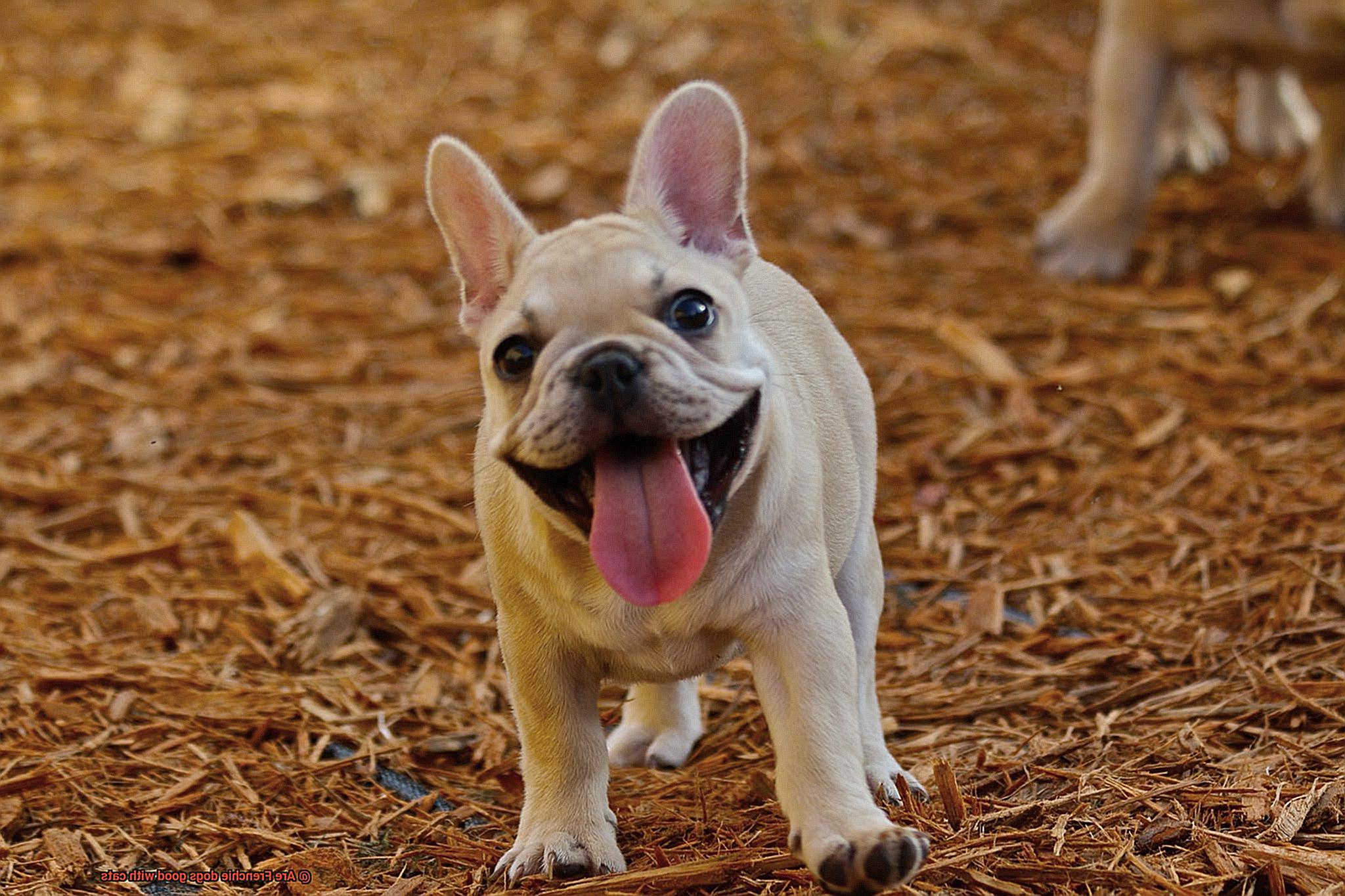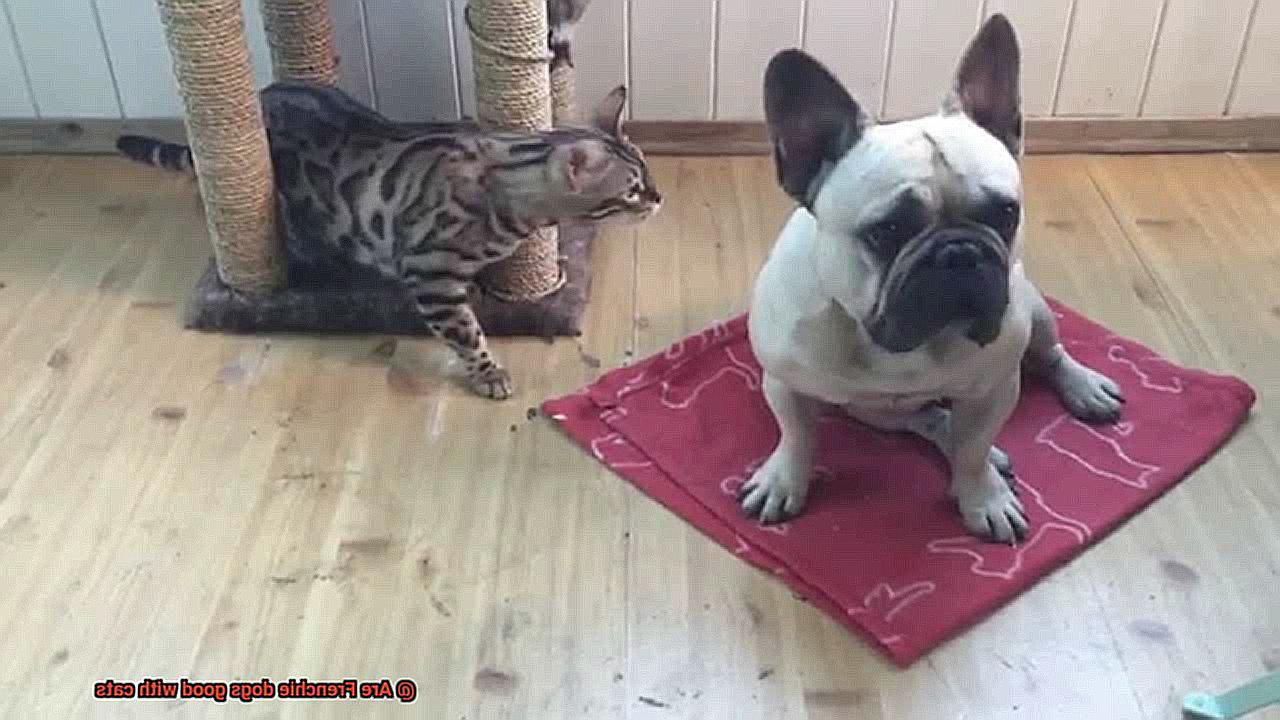Are Frenchie dogs good with cats?
You’re thinking about adding a French Bulldog to your cat-filled kingdom? Or maybe you’ve already got a snorting, squish-faced Frenchie and you’re wondering if they’ll ever get along with a fluffy feline friend. Well, my curious pet-loving pal, you’ve come to the right place.
In this blog post, we’re diving deep into the fascinating world of French Bulldogs and cats. We’ll uncover their personalities, social skills, and spill all the tea on how to create a paw-some friendship between these two adorable creatures.
Get ready for some mind-blowing insights as we unravel the mystery of whether Frenchies and cats can live in perfect harmony. Say goodbye to confusion and hello to a future filled with furry cuddles and endless cuteness.
So grab your favorite cuppa, kick back, and let’s embark on this journey together. Get ready to discover if Frenchie dogs are truly the cat’s meow.
Understanding the Prey Drive of French Bulldogs
Contents
- 1 Understanding the Prey Drive of French Bulldogs
- 2 Socialization: A Key Factor in Frenchie-Cat Relationships
- 3 Training Your Frenchie Dog to Respond to Commands
- 4 Creating a Safe Space for Both Animals
- 5 Supervision During Introductions
- 6 Finding the Right Personality Match for a Frenchie-Cat Relationship
- 7 Exercise and Mental Stimulation for Frenchies
- 8 Patience, Consistency, and Positive Reinforcement are Key Factors in Fostering a Harmonious Coexistence Between a Frenchie Dog and a Cat
- 9 Conclusion
In this article, we’ll delve into the fascinating world of French Bulldogs’ prey drive, drawing on research and personal experiences to provide you with valuable insights.
Understanding Prey Drive:
Prey drive is an instinct deeply ingrained in many dog breeds, including French Bulldogs. It refers to their innate desire to chase, capture, and potentially harm small animals that resemble prey. This instinct stems from their ancestral roots as hunting dogs. French Bulldogs were initially bred for bull-baiting, which required them to possess a strong prey drive.
Variations in Prey Drive:
It’s important to note that prey drive can vary from dog to dog, even within the same breed. Some French Bulldogs may exhibit a higher prey drive, making them more inclined to chase or show aggression towards cats. On the other hand, some French Bulldogs may have a lower prey drive and be more tolerant and friendly towards cats.
Factors Influencing Behavior:
Several factors can influence a French Bulldog’s behavior towards cats. Age, socialization, training, and previous experiences all play significant roles. Early socialization and positive experiences with cats can help reduce the likelihood of aggressive behavior towards them. Therefore, it’s crucial to expose your Frenchie to cats from a young age.
Introducing French Bulldogs to Cats:
Proper training and supervision are essential when introducing a French Bulldog to a cat, regardless of their prey drive level. Slow and supervised introductions allow both animals to become familiar with each other’s presence and scent. It’s advisable to create separate areas in your home where each animal can retreat if they feel overwhelmed.
Managing Prey Drive:
Training your French Bulldog to respond to commands such as “leave it” or “stay” can be helpful in redirecting their attention away from the cat if needed. Regular exercise and mental stimulation are also crucial for French Bulldogs to prevent them from becoming overly focused on chasing or bothering the cat.
Socialization: A Key Factor in Frenchie-Cat Relationships
If you’re a proud owner of a French Bulldog and also have a feline friend at home, ensuring a harmonious relationship between the two is essential. Socialization plays a crucial role in determining the compatibility between French Bulldogs and cats. As an expert in the field, I can provide you with valuable insights on how to foster successful relationships between these adorable creatures.
The Importance of Early Socialization
Early socialization is key when it comes to introducing French Bulldogs and cats. It involves exposing Frenchie puppies to various stimuli, including different animals, people, and environments. This exposure helps them develop positive associations and learn appropriate behaviors towards other animals, such as cats. By starting socialization from a young age, you lay the foundation for a positive relationship between your Frenchie and your cat.
Introducing Frenchie Dogs to Cats
When introducing a Frenchie dog to a cat, it’s important to take things slow and controlled. Gradual introductions allow both animals to become familiar with each other’s presence without feeling overwhelmed or threatened. Start by keeping them separated initially and gradually increase their supervised interactions over time.
Supervision and Positive Reinforcement
During the initial interactions between your Frenchie dog and your cat, supervision is crucial. It ensures their safety and prevents any aggressive behavior. Be sure to reward both animals for calm and polite behavior using positive reinforcement techniques such as treats or praise. This helps shape desirable behaviors in both your Frenchie dog and your cat when they are together.
Consider Individual Personalities
It’s important to note that the individual personalities of both your Frenchie dog and your cat will also play a role in their compatibility. Some Frenchie dogs may naturally have a higher prey drive, making them more inclined to chase or exhibit predatory behavior towards cats. On the other hand, some cats may be more tolerant and accepting of dogs, while others may be more fearful or territorial. Understanding and respecting these personality traits is essential for a successful Frenchie-cat relationship.
Fostering a Positive Relationship Over Time
Regular supervised interactions and gradual exposure can help foster a positive relationship between your Frenchie dog and your cat over time. Patience, consistency, and positive reinforcement are key in ensuring a successful integration of your Frenchie dog into a household with cats. Remember, every animal is unique, so it may take time for them to establish trust and form a bond.
Socialization is indeed a key factor in developing successful relationships between French Bulldogs and cats. By providing your Frenchie dog with early socialization, introducing them to your cat gradually, supervising their interactions, and using positive reinforcement techniques, you can create a harmonious environment for both animals to thrive. With patience and love, your Frenchie and your cat can become the best of friends in no time.
Training Your Frenchie Dog to Respond to Commands
French Bulldogs are intelligent and eager to please, making them highly trainable when it comes to responding to commands. With consistent training, positive reinforcement techniques, and socialization, you can effectively teach your Frenchie to obey your commands and become a well-behaved companion.
Start Early and Be Consistent:
Begin training your Frenchie at a young age to establish good habits and obedience. Use the same command words and hand signals consistently, as this helps them understand what is expected of them.
Use Positive Reinforcement:
Positive reinforcement techniques, such as rewards and praise, work wonders with French Bulldogs. When your Frenchie follows a command correctly, reward them with treats or verbal praise. This encourages them to repeat the behavior in the future.
Keep Training Sessions Short and Frequent:
Frenchie dogs have short attention spans, so keep training sessions brief and engaging. Aim for multiple short sessions throughout the day rather than one long session. This helps maintain their focus and prevents boredom.
Start with Basic Commands:
Begin with basic commands like sit, stay, and come. Once your Frenchie has mastered these commands, gradually progress to more advanced ones. Remember to always reinforce the basics during training sessions.

Gradually Reduce Treats:
While treats are effective rewards during training, it is important to gradually reduce their use as your Frenchie becomes more proficient in following commands. This helps prevent over-reliance on treats and ensures that they respond even without a reward.
Socialize Your Frenchie:
Socialization is crucial for French Bulldogs to learn how to interact with other animals, including cats. Introduce your Frenchie to cats in a controlled environment, allowing them to observe and interact under supervision. Reward and praise positive interactions while redirecting any unwanted behaviors towards cats.
Remember that individual temperament can vary among dogs, so not all French Bulldogs may have a natural affinity for cats. If your Frenchie shows signs of aggression or discomfort around cats, consult a professional dog trainer or behaviorist for guidance on how to address the issue.
Creating a Safe Space for Both Animals
When it comes to introducing a French Bulldog and a cat, creating a safe space for both animals is crucial. It sets the foundation for a peaceful coexistence and ensures the well-being of both furry friends.
In this article, we will explore the importance of understanding their needs, gradual introductions, providing separate spaces, supervised interactions, positive reinforcement, patience, and seeking professional help if needed.
Understanding the Needs of Each Animal:
French Bulldogs are generally sociable and friendly dogs, while cats tend to be more independent and territorial. Recognizing and respecting these differences is key to creating a safe space for both animals.
French Bulldogs require social interaction and exercise, while cats need their own space and vertical territory. Meeting these needs will help prevent conflicts and promote harmony.
Gradual Introduction:
Introduce your French Bulldog and cat slowly and gradually to allow them to become familiar with each other’s scents and presence. Use baby gates or separate rooms initially to create a barrier between them. This way, they can observe each other without direct contact, reducing stress and potential conflicts.
Providing Separate Spaces:
Both animals should have their own designated spaces within the home. This ensures they have their own territory where they can retreat to if needed. Consider using cat trees or high perches for your feline friend, while providing a cozy bed or crate for your French Bulldog. Having separate spaces promotes a sense of security for both animals.
Supervised Interactions:
During the initial stages of their relationship, it’s important to supervise interactions between your French Bulldog and cat. This allows for immediate intervention if any signs of aggression or discomfort arise. Use a leash for your Frenchie to have control over their movements, and provide high perches or hiding spots for your cat to escape to if needed.
Positive Reinforcement and Rewards:
Positive reinforcement plays a vital role in creating a safe space for both animals. When your French Bulldog and cat exhibit desirable behavior towards each other, reward them with treats or praise. This reinforces positive associations and helps build trust between them. Examples of desirable behavior include calmness and respectful distance.
Patience and Time:
Creating a safe space for both animals takes time and patience. It may take weeks or even months for them to fully adjust to each other’s presence. Avoid rushing the process, as forcing interactions can lead to stress and potential conflicts. Be patient and allow them to set the pace of their relationship.
Seeking Professional Help:
If despite your best efforts, your French Bulldog and cat are not getting along, it may be beneficial to seek the assistance of a professional animal behaviorist. These experts can provide tailored advice and strategies to help resolve any conflicts and ensure a harmonious coexistence between both animals.
Supervision During Introductions
Introducing a French Bulldog to a cat can be an exciting but nerve-wracking experience. Both animals have their own unique personalities and instincts, and it’s important to ensure their safety and comfort during the initial introductions. In this guide, we will explore how supervision plays a crucial role in creating a successful relationship between a French Bulldog and a cat.
Constant Supervision:
During the initial introductions, it is essential to provide constant supervision. This allows you to intervene if any signs of aggression or discomfort are displayed by either the Frenchie or the cat. By being present and attentive, you can prevent potential conflicts and ensure the safety of both pets.
Leashes and Crates:
To maintain control over your French Bulldog’s movements and prevent any sudden or aggressive behavior towards the cat, it is recommended to keep your Frenchie on a leash or in a crate during the introductions. This helps create a safe environment for both pets and allows for easier management of their interactions.
Creating a Safe Space:
It’s important to create a safe space for your cat where they can observe the dog from a distance. Provide access to high places such as tall cat trees or shelves where the cat can feel secure and in control of its own space. This helps reduce stress and anxiety for the cat during the introductions.
Gradual Introductions:
Start with short, supervised sessions where the Frenchie and the cat can see each other from a distance. Over time, gradually increase the length of these sessions as both animals become more comfortable with each other’s presence. This gradual approach allows them to adjust at their own pace and minimizes the chances of overwhelming or stressful situations.
Positive Reinforcement:
Positive reinforcement is essential during these introductions. Reward both the Frenchie and the cat for calm behavior and positive interactions. Treats, praises, and gentle petting can help create positive associations between the two pets, reinforcing their bond and encouraging them to form a harmonious relationship.
Unique Dynamics:
It’s important to remember that every Frenchie and cat dynamic is unique. Some French Bulldogs may have a natural inclination to get along with cats, while others may require more time and guidance. Patience and consistency are key in facilitating a successful relationship between a Frenchie and a cat.
Seeking Professional Help:
If any signs of aggression persist or escalate during the introductions, it may be necessary to seek professional help from a trainer or behaviorist who specializes in inter-pet relationships. They can provide expert guidance tailored to your specific situation and help you navigate any challenges that arise.
Finding the Right Personality Match for a Frenchie-Cat Relationship
Creating a successful Frenchie-Cat relationship requires finding the right personality match between your French Bulldog and your cat. Each animal has its own unique temperament and preferences, so it’s important to assess their individual personalities before introducing them. In this article, we will explore the process for finding the right match and provide tips for a successful introduction.
Assessing Your Frenchie’s Personality:
French Bulldogs are generally affectionate, sociable, and friendly. However, some may have a more dominant or territorial nature. It’s important to observe your Frenchie’s behavior around other animals to determine their compatibility with a cat.
Understanding Your Cat’s Personality:
Cats also have varying personalities. Some cats are more tolerant and adaptable, while others may be more independent and cautious. Consider your cat’s temperament and social preferences to gauge their compatibility with a Frenchie.
Creating a Safe Space:
Before introducing your Frenchie and cat, create a safe and neutral space where they can interact without feeling threatened. This could be a separate room or area in your home. Make sure both animals have their own spaces to retreat to if needed.
Slow and Gradual Introductions:
Start by allowing them to sniff each other’s scents through closed doors or gates. This helps them become familiar with each other without direct contact. Once comfortable, introduce them face-to-face under controlled circumstances. Monitor their body language and reactions closely.
Positive Reinforcement:
Use positive reinforcement techniques during the introduction process. Reward both animals with treats and praise for calm and friendly behavior. This helps create positive associations between them.
Consider Previous Experiences:

The success of a Frenchie-Cat relationship also depends on previous experiences and socialization. If either animal has had negative encounters with the other species in the past, extra care and patience may be required to build trust and confidence.
Exercise and Mental Stimulation for Frenchies
French Bulldogs have moderate exercise requirements and do not need excessive amounts of physical activity. However, they still need daily walks and playtime to burn off energy and maintain a healthy weight. Here are some tips on how to provide physical exercise for your Frenchie:
- Daily walks: Take your Frenchie for a brisk 30-minute walk in the morning and another in the evening. This will help meet their exercise needs and keep them fit. Keep in mind that Frenchies have a flat face, so monitor their breathing and avoid overexertion, especially during hot weather.
- Interactive play sessions: French Bulldogs love playing with their owners. Engage them in games like fetch or tug-of-war, which provide both physical exercise and mental stimulation. These activities also help strengthen the bond between you and your Frenchie.
Mental Stimulation for Frenchies: Toys and Training
French Bulldogs are intelligent and curious dogs that thrive with mental stimulation. Here are some techniques to keep your Frenchie mentally sharp:
- Puzzle toys: Invest in puzzle toys that require your Frenchie to figure out how to retrieve treats or toys from inside. This keeps them entertained and mentally challenged. Just make sure to choose toys that are safe for Frenchies, as they have a tendency to chew on things.
- Training sessions: French Bulldogs are easy to train due to their intelligence and eagerness to please. Teach them new commands or tricks to engage their minds and strengthen the bond between you and your furry friend. Positive reinforcement techniques, such as using treats or praise, work best with Frenchies.
Socialization for Frenchies: Introducing Cats and Other Pets
Socialization is crucial for French Bulldogs to prevent behavioral issues and ensure they are comfortable in various situations. When introducing your Frenchie to cats or other pets, follow these steps:
- Gradual introduction: Introduce your Frenchie to cats or other pets gradually and under supervision. This allows them to get used to each other’s presence in a controlled environment.
- Positive reinforcement: Use positive reinforcement techniques during the introduction process. Reward both the Frenchie and the cat for calm and friendly behavior, and provide treats or praise as a reward.
Patience, Consistency, and Positive Reinforcement are Key Factors in Fostering a Harmonious Coexistence Between a Frenchie Dog and a Cat
Building a harmonious relationship between a Frenchie dog and a cat requires patience, consistency, and positive reinforcement. In this blog post, we will delve into the key factors that will help you create a peaceful coexistence between these two adorable pets.
Patience: Slow and Steady Wins the Race
Introducing a Frenchie dog to a cat should never be rushed. Both pets need time to adjust to each other’s presence. Here are some tips for practicing patience:
- Gradual introductions: Start by keeping them separated and gradually allow supervised interactions over time.
- Scent swapping: Exchange bedding or rub a cloth on one pet’s scent glands to familiarize them with each other’s smells.
- Supervision: Always keep an eye on them during early interactions to address any signs of aggression or discomfort promptly.
Consistency: Establishing Boundaries and Routines
Creating stability and balance in your household is crucial for a harmonious coexistence. Here’s how you can achieve consistency:
- Enforce rules consistently: Set clear boundaries for both pets and ensure they are consistently enforced.
- Structured interactions: Provide structured playtime and mealtime routines to establish a sense of predictability.
- Separate spaces: Create separate spaces for each pet within the home to give them their own territories.
Positive Reinforcement: Rewarding Good Behavior
Positive reinforcement is the key to fostering positive associations between your Frenchie dog and cat. Consider the following strategies:
- Treats and praise: Reward both pets with treats or verbal praise whenever they display friendly and calm interactions.
- Playtime: Encourage play sessions where both pets can engage in fun activities together.
- Training and socialization: Continue training and socializing both pets individually to prevent behavioral issues.
Additional Tips and Considerations
- Understand individual personalities: Remember that every pet is unique, and their compatibility can vary. Adjust your approach based on their specific needs.
- Seek professional guidance: If you’re facing challenges in the process, don’t hesitate to consult a veterinarian or animal behaviorist for personalized advice.
Conclusion
In conclusion, Frenchie dogs and cats can actually get along quite well.
These adorable little pups have a friendly and adaptable nature that allows them to form strong bonds with feline friends. With proper introduction, socialization, and supervision, Frenchies can coexist peacefully with cats in the same household.
It’s important to remember that every individual dog and cat is unique, so there may be exceptions to this generalization. However, overall, Frenchie dogs have the potential to be great companions for our feline friends.
So if you’re considering adding a Frenchie to your family but already have a cat, don’t fret.




